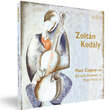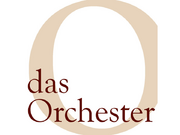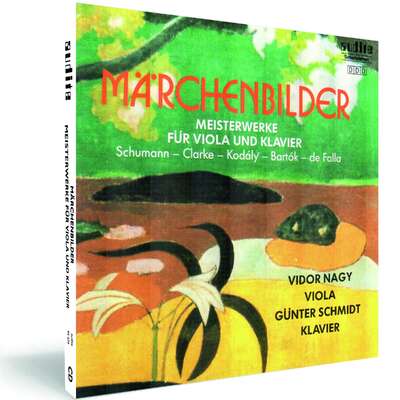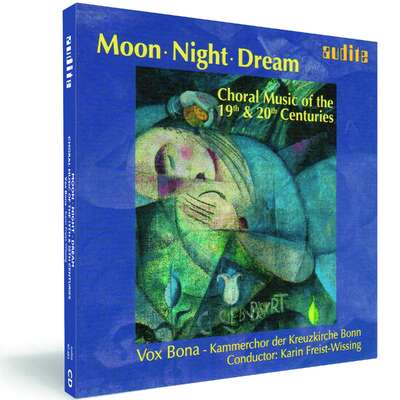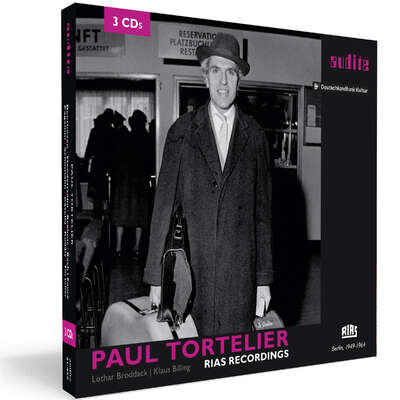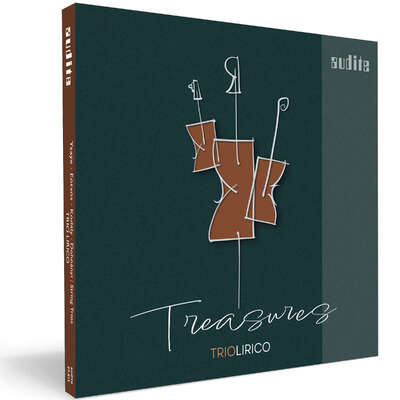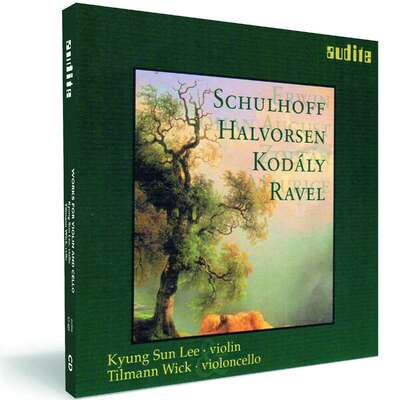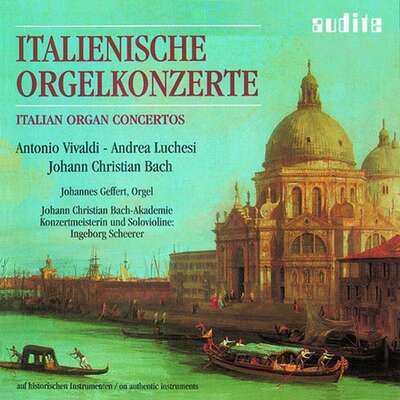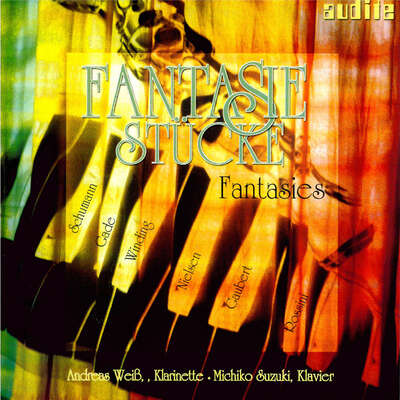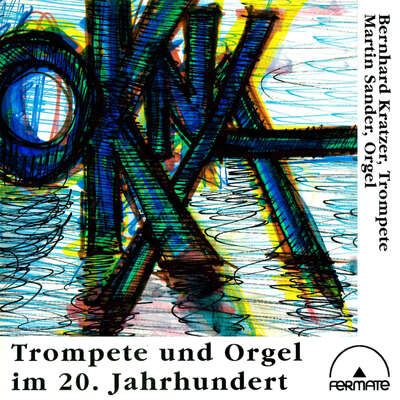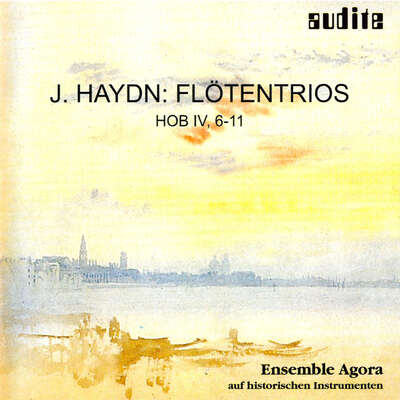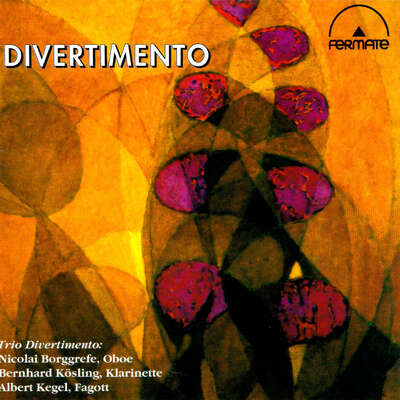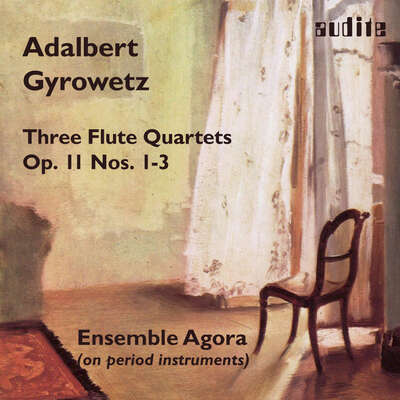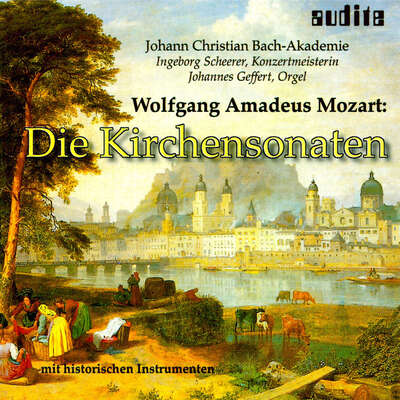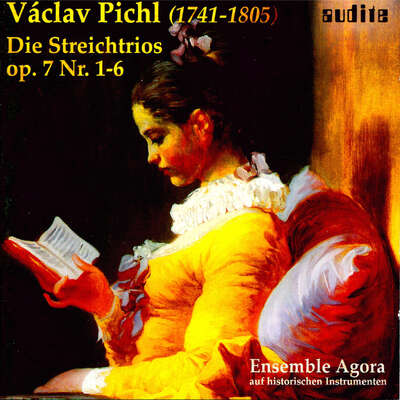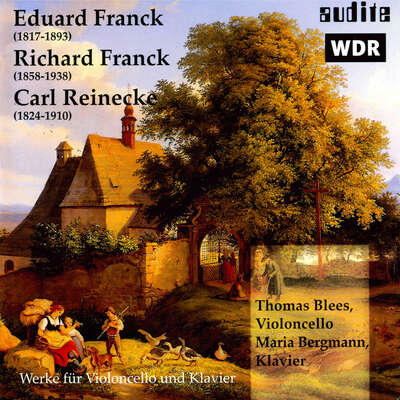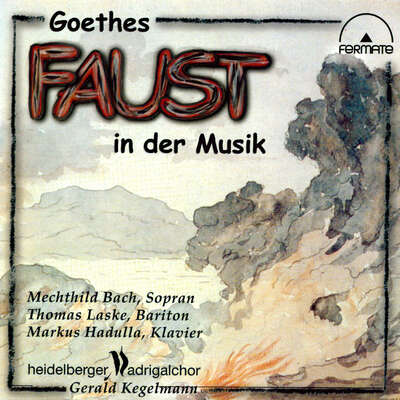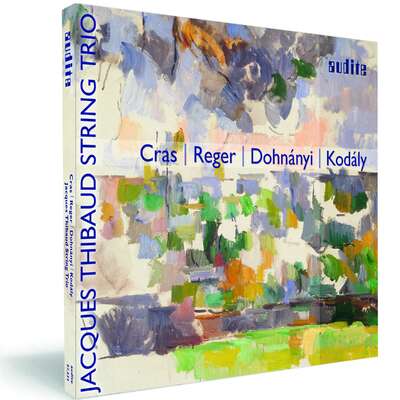
Auto-Rip
Zoltán Kodály was the Hungarian national composer of the twentieth century. But he was also one of the most eminent composers for the cello: it was to this instrument that he dedicated the passionate and sublime works recorded on this CD. more
"Marc Coppey [...] spielt Kodálys Musik mit Verve, Passion und zugleich perfekter Detailkontrolle. Die halsbrecherischen Schwierigkeiten der Solosonate erklingen unter seinen Händen mühelos" (Das Orchester)
Details
| Zoltán Kodály: Chamber Music for Cello | |
| article number: | 97.794 |
|---|---|
| EAN barcode: | 4022143977946 |
| price group: | BCA |
| release date: | 4. March 2022 |
| total time: | 81 min. |
Bonus Material
Informationen
The common question as to who was the most important Hungarian composer of the twentieth century - Béla Bartók or Zoltán Kodály - would have been vehemently rejected by the two like-minded friends. On the one hand, they shared many ideas and goals, such as researching Hungarian folk music, which they recorded in the countryside before and after the First World War using a wax cylinder phonograph. Bartók and Kodály made the original music of the peasant societies, which has nothing to do with the idea of Csárdás fire and Puszta romanticism, the basis of their own idioms, which they further developed in very personal ways. On the other hand, the careers of the two composers progressed in entirely different ways. While Bartók embraced international modernism and went into American exile at the height of fascist rule in Hungary, Kodály remained in his home country even under politically difficult circumstances, devoting himself unswervingly to his great task: integrating music into the school curriculum in order to make it the basis of national consciousness and social behaviour.
Reviews
Classica – le meilleur de la musique classique & de la hi-fi | N° 259 - Février 2024 | Michel Le Naour | February 1, 2024
L’œuvre en bref
Sonate pour violoncelle seul de Zoltán Kodály
[...] tandis que Marc Coppey, chambriste confirmé et plus idiomatique, manifeste quelques baisses de tension dans le finale.Mehr lesen
Das Orchester | 10/22 | Gerhard Anders | October 1, 2022 | source: https://dasorche...
Marc Coppey [...] spielt Kodálys Musik mit Verve, Passion und zugleich perfekter Detailkontrolle. Die halsbrecherischen Schwierigkeiten der Solosonate erklingen unter seinen Händen mühelosMehr lesen
www.on-mag.fr | 21 septembre 2022 | Jean-Pierre Robert | September 21, 2022 | source: https://www.on-m... CD : la musique de chambre pour violoncelle de Zoltán Kodály
La prise de son dans une église berlinoise à l'acoustique ouverte, dispense un excellent relief sur les instruments.Mehr lesen
Classica – le meilleur de la musique classique & de la hi-fi | N° 244 - Juillet-Août 2022 | Jérémie Cahen | July 1, 2022
[Marc Coppey] d’autant qu’il y déploie un imaginaire sonore parfaitement assorti aux phrasés anguleux de l’ouvrage. Tout sonne juste dans ce premier mouvement tiré au cordeau, où l’accentuation acérée du discours s’accompagne d’une grande richesse de timbres. On admire le soin extrême apporté aux nuances dans un Adagio à la fois ascétique et profondément tourmenté. Mehr lesen
Rhein-Main Magazin | 07/22 | Sebastian Laux | July 1, 2022
Zoltán Kodály war der ungarische Nationalkomponist des 20. Jahrhunderts. Aber er war auch einer der bedeutendsten Komponisten für das Violoncello,Mehr lesen
Fono Forum | Juni 2022 | Dorothee Riemer | June 1, 2022
Die Cello-Kammermusik von Kodály ist eine große technische Herausforderung, braucht aber auch ein hohes Maß an Ausdrucksfähigkeit und ein tiefesMehr lesen
Diapason | N° 712 JUIN 2022 | Patrick Szersnovicz | June 1, 2022
Beauprogramme, qui reflète la période (environ de 1908 à 1921) la plus féconde et prospective de Zoltan Kodaly, celle où, forte de la découverteMehr lesen
Premier chef-d’œuvre du genre depuis les Suites de Bach, la prodigieuse Sonate pour violoncelle seul op. 8 (1915) révèle une utilisation toute personnelle de la forme sonate et une exploitation proprement fabuleuse des ressources expressives et techniques de l’instrument : il n’est pas étonnant qu’elle ait servi d’étalon aux meilleures pages pour violoncelle seul écrites plus tard par Ligeti, Zimmermann, Xenakis, Berio et quelques autres. Marc Coppey en offre une interprétation austère. La volonté d’introspection et le refus du spectaculaire deviennent ici un défi, tant l’œuvre semble réclamer la flamboyance virtuose la plus éclatante, assumée et intégrée dans des versions légendaires (Starker, Fournier, Perényi) comme dans des références plus récentes (Mørk, Phillips). Mais notre violoncelliste strasbourgeois, s’astreignant à un rigoureux respect de la lettre, insuffle une intensité très convaincante dans les trois mouvements puissamment architecturés.
Tout aussi économe d’effets, l’approche de la Sonate op. 4 (1909) avec le pianiste Matan Porat apporte son lot de détente et de fantaisie, fascinant paradoxe s’agissant d’une partition aussiramassée, pétrie d’invention, d’ambiguïtés tonales et rythmiques. Ce climat poétique et d’une grande beauté lyrique trouve un prolongement dans la brève Sonatine (mouvement peut-être originellement destiné à la sonate précédente), tandis que les trois mouvements du Duo op. 7 (1914) nous ramènent à l’ampleur et à la substance de l’Opus 8, épanouies en un magnifique contrepoint linéaire. Marc Coppey et l’excellent violoniste hongrois Barnabas Kelemen, malgré leur flexibilité de diction, privilégient l’aspect anguleux et l’extrême modernité de l’écriture davantage que son côté rhapsodique.
Preis der Deutschen Schallplattenkritik
| 16. Mai 2022 | Elisabeth Richter | May 16, 2022 | source: https://www.scha...
Bestenliste 2/2022 PdSK
Gewinner Kategorie "Kammermusik"
Im Jahr 1915, als Kodály seine Cello-Solosonate schrieb, verzweifelten die Interpreten noch an den damals ungewöhnlichen Techniken, den hohen Lagen,Mehr lesen
Radio France
| vendredi 6 mai 2022 | Jean-Baptiste Urbain | May 6, 2022 | source: https://www.radi...
BROADCAST
L'invité du jour
Des élans passionnés de Saint-Saëns et de Lalo, aux accents révolutionnaires de Kodaly, Marc Coppey célèbre, à travers ses deux nouveaux albums, quelques-uns des plus beaux chefs d’œuvres du répertoire pour violoncelle.Mehr lesen
Record Geijutsu | 01.05.2022 | May 1, 2022
Japanische Rezension siehe PDF!Mehr lesen
www.musicweb-international.com | Thursday April 28th | Stephen Barber | April 28, 2022 | source: http://www.music...
Kodály was less prolific than his great friend Bartók and most of his works come early in his life. Composition was for him secondary to improvingMehr lesen
In them he practises a fusion of traditional Western music with the techniques he and Bartók had learned from the folk music they assiduously collected. These used different scales and rhythms from those in the Austrian and German music which had previously been dominant. Kodály was also influenced by Debussy, who himself had been impressed by the music of East Asia which he had heard at the Paris Expositions Universelles and from which he had adopted techniques in his own music.
The three works here are similar in their idiom and all require a great deal of virtuosity from the cellist. The instrument is frequently taken up into its highest register, is required to perform complicated double and multiple stopping and deliver a range of special sound effects. Kodály also uses frequent changes of tempo and a good deal of freedom in rhythm, to give the impression of improvising, though everything is carefully notated.
We begin with the sonata for solo cello. This was, I believe the first such work since the cello suites of Bach, although Max Reger was also writing for the solo cello at around the same time. Kodály requires the cello to adopt scordatura, a baroque device in which the tunings of the strings are different from the standard ones. Here, the two lower strings, normally C and G, are tuned down to B and F-sharp, which changes the timbre and resonance of the instrument and not only in the lower range. There are three movements, respectively fast, slow and fast, and the first movement particularly exploits the higher range. The central Adagio has the feel of an improvisation while the final Allegro is one of those fast dance movements which Bartók also liked to write.
The Sonata for cello and piano is in only two movements, Kodály having rejected his original opening movement. We begin with a Fantasia, starting with the cello unaccompanied. When the piano joins in, it is given the kind of writing we associate with the Hungarian cimbalon, in which the player uses beaters directly on the strings. We then have another fast movement, but with sudden pauses and virtuosic outbursts and, surprisingly, with a quiet ending.
Some twelve years after composing this sonata Kodály thought again about providing an opening movement and wrote one, though it was not published until 1969, after his death. It is titled Sonatina. It begins with a piano solo and then moves into an elegiac movement. It is a little strange that on this disc it is placed after, rather than before, the work for which it was written as a prelude.
Finally, we have the Duo for violin and cello. This preceded Ravel’s rather better-known sonata for this combination, which dates from 1920-2. This is in three movements. In it the violin and cello vie with each other, throwing scraps of melody to and fro and urging each other to technical display. Kodály writes for this difficult combination as to the manner born, and the result is an exhilarating work.
The solo cello sonata is the best-known of these works and has become famous. At first it was received poorly, but the composer said presciently ‘In twentyfive years no cellist will be accepted who has not played it.’ It was the cellist János Starker who made the work well-known, first playing it to the composer in 1939 when he was fifteen. He went on to record it four times. I must admit to not having heard a performance by him, but I can’t believe it is superior to the one here by Marc Coppey, whose playing seems to me outstanding. I was gripped throughout. He is also very ably partnered by Matan Porat in the sonata for cello and piano and by Barnabás Kelemen in the Duo. These works are all masterpieces and here they receive performances they deserve. The recording is superb – splendidly present without being harsh. The booklet is good, though it discusses the works in chronological order and not that on the disc. It is a shame that Kodály did not continue to write chamber music.
www.arts-spectacles.com | Jeudi 14 Avril 2022 | Pierre Aimar | April 14, 2022 | source: https://www.arts... Marc Coppey revisite les grandes pages du violoncelle romantique et modern
Enregistrer la sonate pour violoncelle seul de Kodaly est l’aboutissement d’une longue et intense fréquentation de cette partition parmi les plus redoutables et les plus fascinantes du répertoire. Une œuvre pour laquelle Marc Coppey a bénéficié des précieux conseils du grand violoncelliste et pédagogue Janos Starker, qui étudia lui-même auprès du compositeur hongrois. Mehr lesen
www.artalinna.com
| 14 AVRIL 2022 | Jean-Charles Hoffelé | April 14, 2022 | source: http://www.artal...
LE DISQUE DU JOUR
LE VIOLONCELLE PARLE
[...] c’est merveille d’entendre Marc Coppey en saisir l’urgence comme les méditations, faire résonner les registres si différentsMehr lesen
The Art Music Lounge | MARCH 21, 2022 | Lynn René Bayley | March 21, 2022 | source: https://artmusic... Coppey’s Fiery Kodály
[...] considering the fact that Várdai is Hungarian and Coppey is French, the latter really “gets” this music in the same gutsy, energetic style. And, to be honest, Coppey has the better tone: rich, deep and full [...] Moreover, Coppey’s richer tonal palette allows him to access a greater range of sounds and colors from his instrument. Another thing that works in his favor is the sound quality. [...] This now my go-to recording of these pieces. As good as Várdai was, Coppey outstrips him.Mehr lesen
www.highresaudio.com | März 2022 | March 4, 2022 | source: https://www.high... LISTENING TIPP
Der Cellist Marc Coppey [...] spielt in der Solosonate herausfordernd direkt, mit den Zuhörer anspringender Intensität auf und lässt die Sonatine in all ihrer Schönheit aufblühen. Matan Porat am Klavier und Barnabás Kelemen mit seiner Violine, beide Meister ihres Fachs, erweitern die Klangwelt des formidablen Cellospiel Marc Coppeys ganz im Sinne des ungarischen Komponisten in Sachen Farbigkeit und Rhythmus.Mehr lesen
www.pizzicato.lu | 03/03/2022 | Uwe Krusch | March 3, 2022 | source: https://www.pizz... Marc Coppey verschafft den Einblick bei Kodaly
Die wesentlichen Kammermusikwerke für das Cello von Zoltan Kodaly hat der aus Straßburg stammende Marc Coppey zusammen mit Freunden für eineMehr lesen
Coppey spielt gleich in der Solosonate herausfordernd direkt, so dass seine Interpretation den Zuhörer mit ihrer Intensität anspringt. Das ergibt eine Sichtweise, die man nicht nebenbei abtun kann. Man wird als Zuhörer sofort eingesogen ins Geschehen. Diese Qualität des Herangehens kann Coppey die gesamte Strecke über überzeugend halten. In der Sonate mit Klavier lässt er der einleitenden Fantasia einen weiten Raum der Entfaltung und Ruhe, der im Vergleich zum Vorhergehenden entspannt klingt und sich erst im Laufe des Satzes wieder etwas aufbaut. Ob das anschließende Adagio einmal als weiterer Satz zu der nur zweiteiligen Sonate gedacht war, wird sich nicht nachvollziehen lassen. Aber auch als Einzelsatz mit der ausgreifenden, an das Cymbal erinnernden Klaviereinleitung und Bezügen zur Volksmusik der ungarischen Heimat entfaltet Kodaly seine ebenso persönliche wie auch heimatgebundene Stimme. Das Duo, das nicht nur mit technischen Hürden, sondern auch spielfreudigen Szenen garniert ist, schließlich bietet den reizvollen Abschluss. Auch hier sind Kelemen und Coppey sich in der gepflegt zugreifenden Herangehensweise einig und es gelingt ihnen, die modernen Seiten der Komposition hervorzuheben.
-----
The essential chamber music works for cello by Zoltan Kodaly have been recorded by Marc Coppey, a native of Strasbourg, together with friends for a brimming CD. He is supported by Barnabas Kelemen on the violin in the Duo and Matan Porat in the works with piano. Besides the Duo, these are the Solo Sonata, the Sonata with piano and another slow piece with piano.
Coppey’s playing is challengingly direct right from the Solo Sonata, so that his interpretation jumps at the listener with its intensity. This makes for a point of view that cannot be ignored. As a listener, one is immediately sucked into the action. Coppey is able to maintain this interpretative quality convincingly throughout the entire track. In the Sonata with Piano, he allows the opening Fantasia a wide space of development and tranquility, sounding relaxed compared to the preceding and only building up a bit in the course of the movement. Whether the subsequent Adagio was once intended as a further movement to the sonata, which is only in two parts, will be impossible to ascertain. But even as a single movement, with its expansive piano introduction reminiscent of the cymbal and references to the folk music of the Hungarian homeland, Kodaly unfolds his voice, which is as personal as it is tied to his country. Finally, the Duo, garnished not only with technical hurdles but also scenes of joyful playing, provides the delightful conclusion. Here, too, Kelemen and Coppey are united in their cultivated approach, and they succeed in bringing out the modern sides of the composition.
